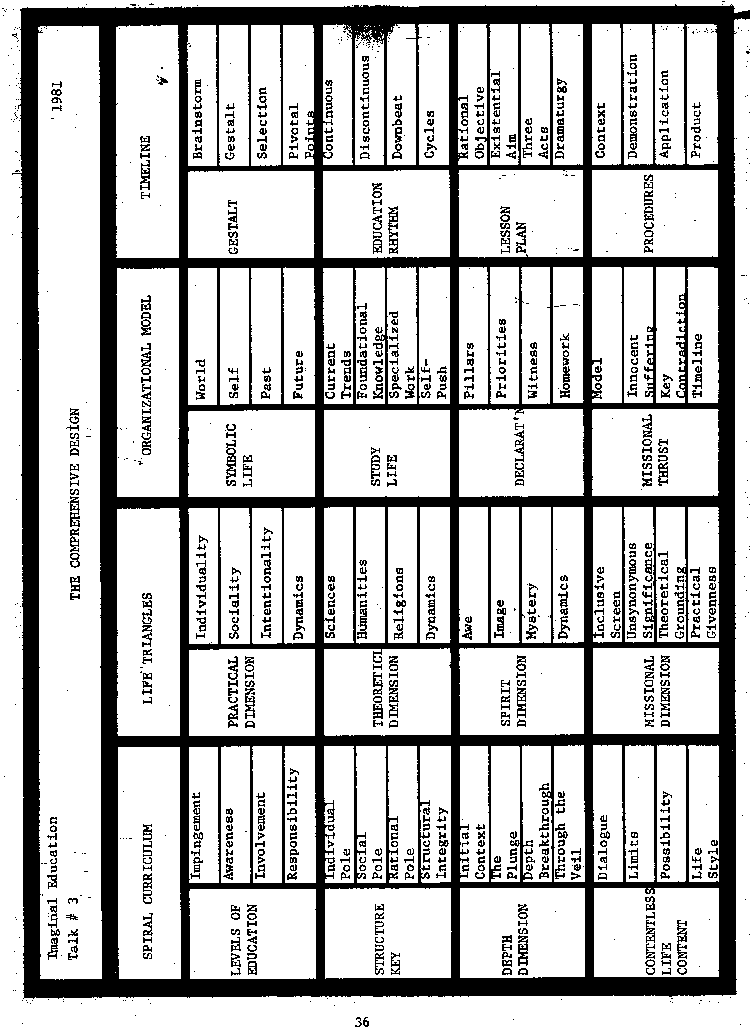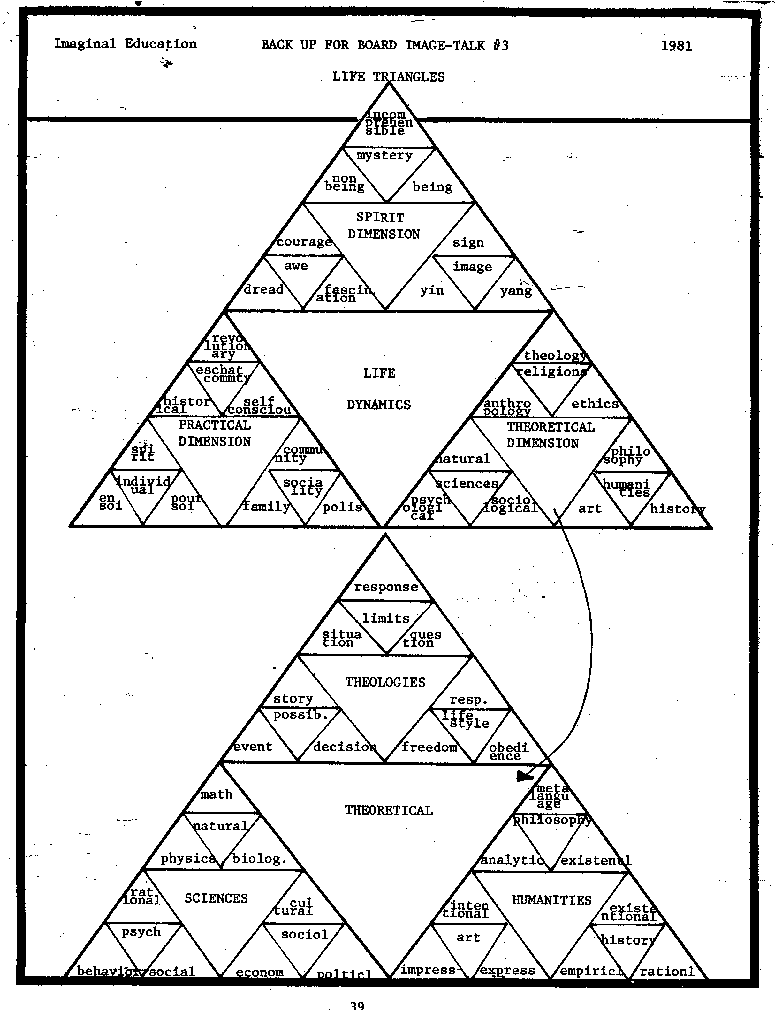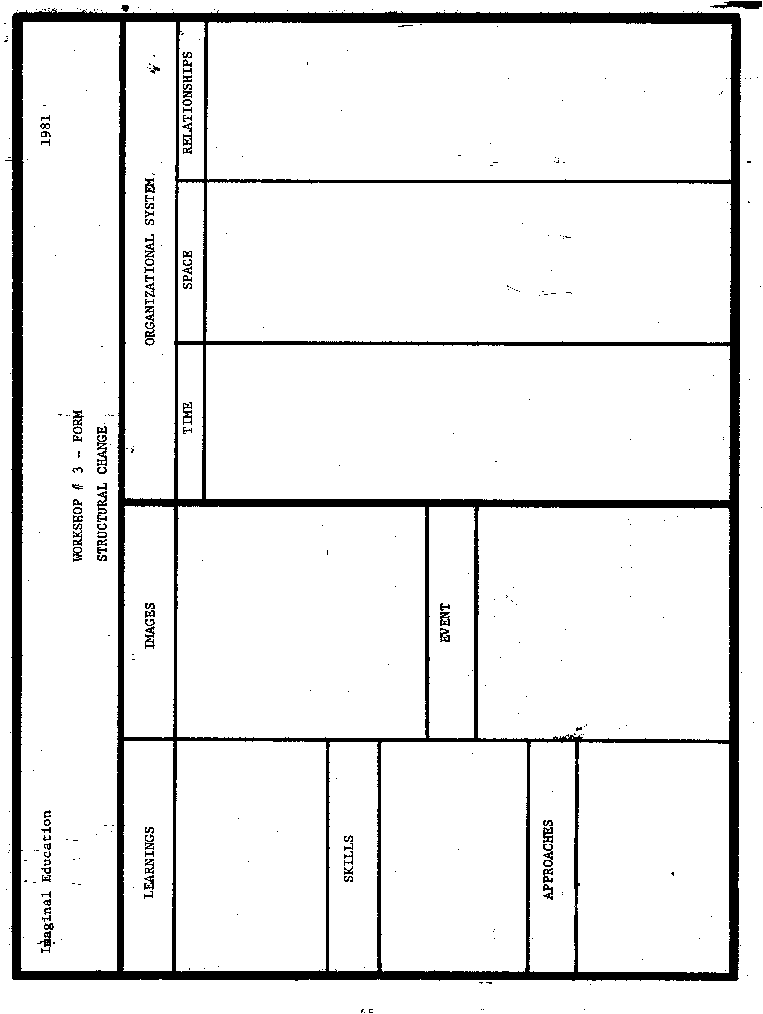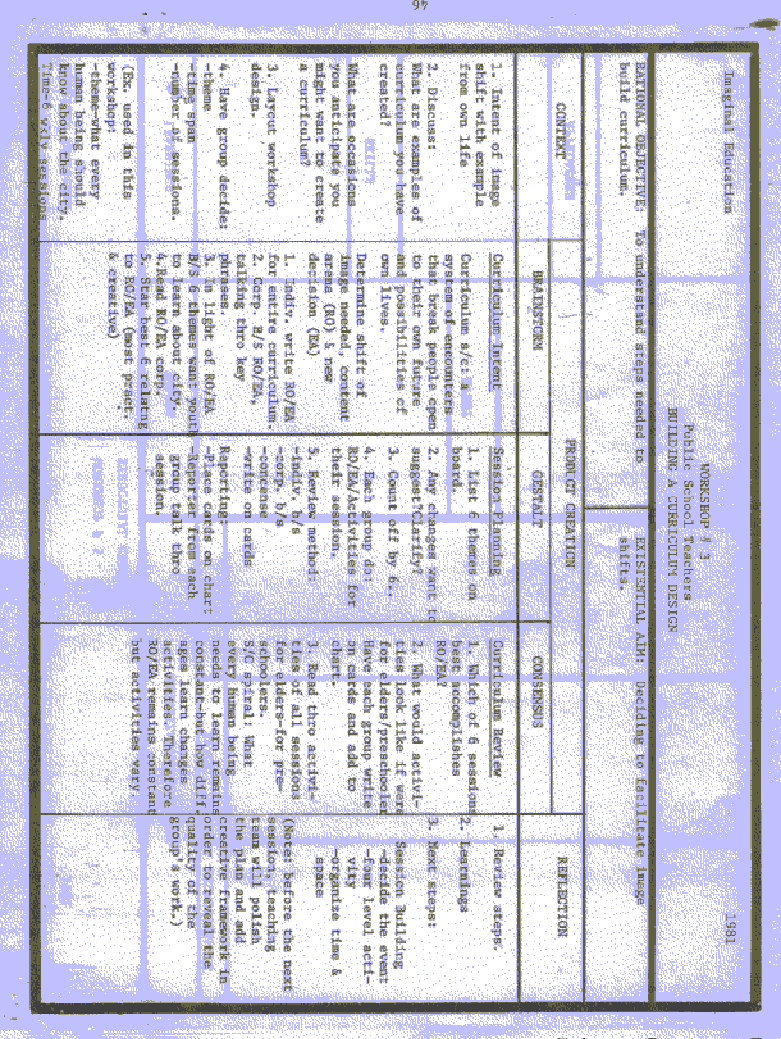
Imaginal Education 1981
MEAL CONSTRUCT III .
TRAINER AS GUIDE
|
MEAL |
RATIONAL OBJECTIVE |
EXISTENTIAL AIM |
|
OBJECTIVE |
To reflect on the changing of images as the major function in training |
Experience the role of the guide in changing people's self understanding |
| CONTEXT | How do you keep a group going once the initial excitement of a task wears off? How do you help a group make it over the long haul? We have found that singing is one of the best activities for keeping a group going.... |
| SONG RITUAL |
Repeat after me: ACTION REMOVES THE DOUBT...THAT THEORY CANNOT SOLVE. |
| MEAL | Let us eat this meal on behalf of the unknown learner .. all humans in every situation are learning. (The demand to provide adequate training for all reminds me of illustration. ) Let us eat on behalf of all who need adequate tools to live effectively in the 20th century. |
| CONVERSA-
TION |
Let us talk for a while about our, task as trainers. |
objective |
1. What comes to mind when you think of the role of a trainer/ educator? |
reflective |
2. Put yourself in the time of the shift from the agricultural age to the industrial age. What major image shifts were happening? 3. What would have been your role as a trainer in that times? |
interpretive |
4. A great deal of writing describes our time as a major period of transition: from civilization to post civilization, or industrialization to post- industrialization. As we move into the 21st century, what image shifts are happening? 5. What will be the role of the trainer/educator as a guide into the next century? |
ANNOUNCEMENTS
SEND OUT Repeat after me: ACTION REMOVES THE DOUBT...THAT THEORY CANNOT SOLVE.

 Imaginal
Education 1981
Imaginal
Education 1981
BACK UP FOR TALK #3
THE COMPREHENSIVE DESIGN
.
In the 1950's, the Institute began its work on curriculum
by asking the questions: What is an educated person? What program of study
will enable that picture of an "educated person" to become a
reality?
Three basic presuppositions were discerned. First, a curriculum for 21st Century people needs to emphasize methodology for thinking and action rather than content. The process by which physics arrived at its operating wisdom is more necessary than the operating wisdom itself. The, capacity to do sociological thinking is more important than knowledge of particular sociological works. A further reason for emphasis on methodology is the colossal amount of available knowledge in the modern world. People's use of human wisdom and experience is limited by their ability to rapidly appropriate the wisdom needed. In addition to intellectual methods, human beings need methods for grappling with their personal destiny and methods for participating in the global social process. A person without clarity on methods for thinking, acting and living can not be called educated.
Second, the content of the educated person's competence
must encompass the entire memory of the human race. Wholeness has to mean
relational mapping, within which any particulars would, in principle, have
their place. A model, called the life triangle was created. In the shaded
part or the theoretical triangle is a relational map of the disciplines
of learning. In this schema, a person is shown as a social being, a solitary
being, and a being over against the inclusive mystery of what sometimes
is called nature. Thus the science triangle organizes science studies under
these categories: the sociological sciences, the psychological sciences
and the natural sciences. The humanities triangle corresponds: history
to a human as social being, art to a human as solitary being and philosophy
to a human as the articulator of the inclusive patterns which provide unity
and meaning to the multiple aspects of the mystery of being.
A curriculum which emphasizes methodology and wholeness
must also be dynamic. It must be adaptable to different ages of human beings,
to different communities, and to the relentless process of historical change.
This means having a model which makes room for variable data. For example,
the natural sciences can be further subdivided into the physical sciences,
the life sciences, and the mathematical sciences. These three arenas of
being can be taught to twoyear olds as well as to eightytwo year
olds, and to the ghetto dweller just as well as to the suburban sophisticate.
But each group of students has its own current images and experience of
life; hence the actual curriculum in both content and methodological training
would vary. Similarly, the curriculum in relation to the disciplines
of biology or physics or mathematics will be different ten years from now.
EDUCATION AND SOCIAL IMBALANCE
Society today is returning toward a balanced society where
culture, including religion, education and style, rightly informs the economic
and political processes. The moral foundations are being forged anew where
communities are being reformulated, religion is refurbished and education
is liferelated and lifelong.
In other times when the great civilizations were at their
peak cultural roots were vital and strong. In European civilization it
was between the 13th and 16th centuries when society was maintained keeping
people in right relation to God, and kings ruled with divine right.
. .
Imaginal Education 1981
THE COMPREHENSIVE DESIGN p.2
.
At other times the political became dominant and new structural
freedoms required other forms of education. In the West it was the 17thand
18th century renaissance where the liberal arts were a means for individual
political participation.
We have just passed through a time when economic dominance
produced a technological revolution unprecedented in scope or innovation.
The education of this period prepared people for the job market. That era
was over when corporations began to do their own training, social as well
as technical. Managerial is being cultivated as one top executive journeys
younger managers in the arts of statecraft and human well-being. The effects
and benefits of economichealth will remain a legacy for the future
enabling the care for all the people. But today creativity, life and social
renewal is at bottom a cultural activity inside the business world as well
as outside.
COMPREHENSIVE CURRICULUM
:
The comprehensive curriculum is based upon the whole life
triangle. The practical aspects to life are learned through the curriculum
as well as the theoretical aspects. In the 20th century the wholeness of
life has returned to human consciousness in a way that it has not been
present since early cave people. Life, action, thought and the beyond are
all mingled together. People today know that all ideas are relative and
all actions situational or contextual. This relativity has thrown human
beings into the awareness of the unknown in life as well as the known.
Both theory and practice are forged, indeed created, by people over against
the unsynonomous aspect of life itself. The mystery of life is both on
our hands and beyond our understandings even as life is being created in
test tubes. Having "come of age" human existence has been brought
into startling relief exposing all its contours, its dread and fascination,
its power and its contingency.
The life triangle is a design or diagram that represents
or points to this wholeness of life. The dichotomies between the sciences
and the humanities are portrayed in polar tension with one another rather
than open divorce or conflict. They are complementary opposites rather
than arch enemies presenting the young with an either/or. Scientist exhibit
poetry and the sensibility of artists. Artists have become masters of technique
and many different media, including electronics and the vibes of musical
intonations and sound. Today the theoretics of religion hold both the sciences
and humanities together in a tripolar tension. Professors and students
alike become gurus to the whole society. The sage emerges again out of
daily experience, and novelists lead the masses of people into the deeps
of life or urexperiences through paperback books.
In a way people are being educated upon the crucible of
life itself instead of or, at least, in addition to the classroom. But
this lifebased curriculum is being intentionally practiced and managed
using classrooms, work days, excursions, art forms and significant endeavors
in human communities. We are educated throughout our total life experience,
but it is possible to hasten the process, to structure it, to render it
more intentional than not and more human than dehumanizing.
,
Imaginal Education 1981
WORKSHOP # 3
STRUCTURAL CHANGE
| RATIONAL OBJECTIVE: To develop the skill of determining the intent of a training design, | EXISTENTIAL AIM: To experience the ability to determine what is to happen to the participants in a training scheme. |
STEP PROCEDURES
CONTEXT Review life triangles from the talk. A comprehensive
training design requires all 3 aspects of education: the foundational pillars
(theoretical); the practical skills; and the selfhood capacity (the Unsynonomous).
.
TEAM Divide into 3 or 4 groups according to actual working situations,
WORK (hospital supervisors, management positions, public
school teachers, etc)
1. List 5 theoretical [earnings that must be learned
in the work situation (reflecting the individual, social, and rational
pole)
( for each list have team members list individually first, and
then create a corporate list for the team.)
List 5 practical skills necessary to this work
situation. (reflecting the individual skill, the social skill and the intentional
decisional skill)
List 5 approaches to the unexpected crisis in the
work situation, e.g. How to deal with violence in the office from public.
(reflecting situations of awe, of dialogue, and with the unknown and the
unknowable.
2. Discern the 5 images that need to be shifted if their
trainees are to learn the above 15 activities, e.g Presenting the public
with a friendly but highly effective face.
3. Discern the mechanism for the death of the old
images in their office, e.g. A major training event, space transformation,
etc.
4. Organize the work situation in terms of time, space, and relations in order to reinforce the positive images just named.
TIME ORGANIZATION SPACE ORGANIZATION RELATIONS STRUCTURE
individual prep time individual space policy (decision
corporate work time corporate work space making)
corporate meeting time corp. meeting space roles in organize
corp. social time corp. social space evaluation of both
public dialogue time public space indiv. and corp.
task.
feedback
5. Put everything on a timeline (1 month to 4 yearsdepending on what is appropriate) relative to the real work situation.
Imaginal Education 1981
STRUCTURAL CHANGE W/S pg. 2
STEP
PROCEDURES
| GROUP
REPORTS |
1. Each group draw their timeline on the board to share in
reporting. 2. Each group report the images to be shifted and the event which will occasion that shift, and then walk through their timeline. |
REFLECTION |
1. What did you notice in these timelines? 2. Where were you surprised? 3. Where do you discern similarities differences? 4. What seems on target relative to actually shifting operating images in the situations? Why? 5. How might this be a useful workshop to use with people in the work? place? 6. What is the new that has occurred to you relative to your task as a trainer? |
..

